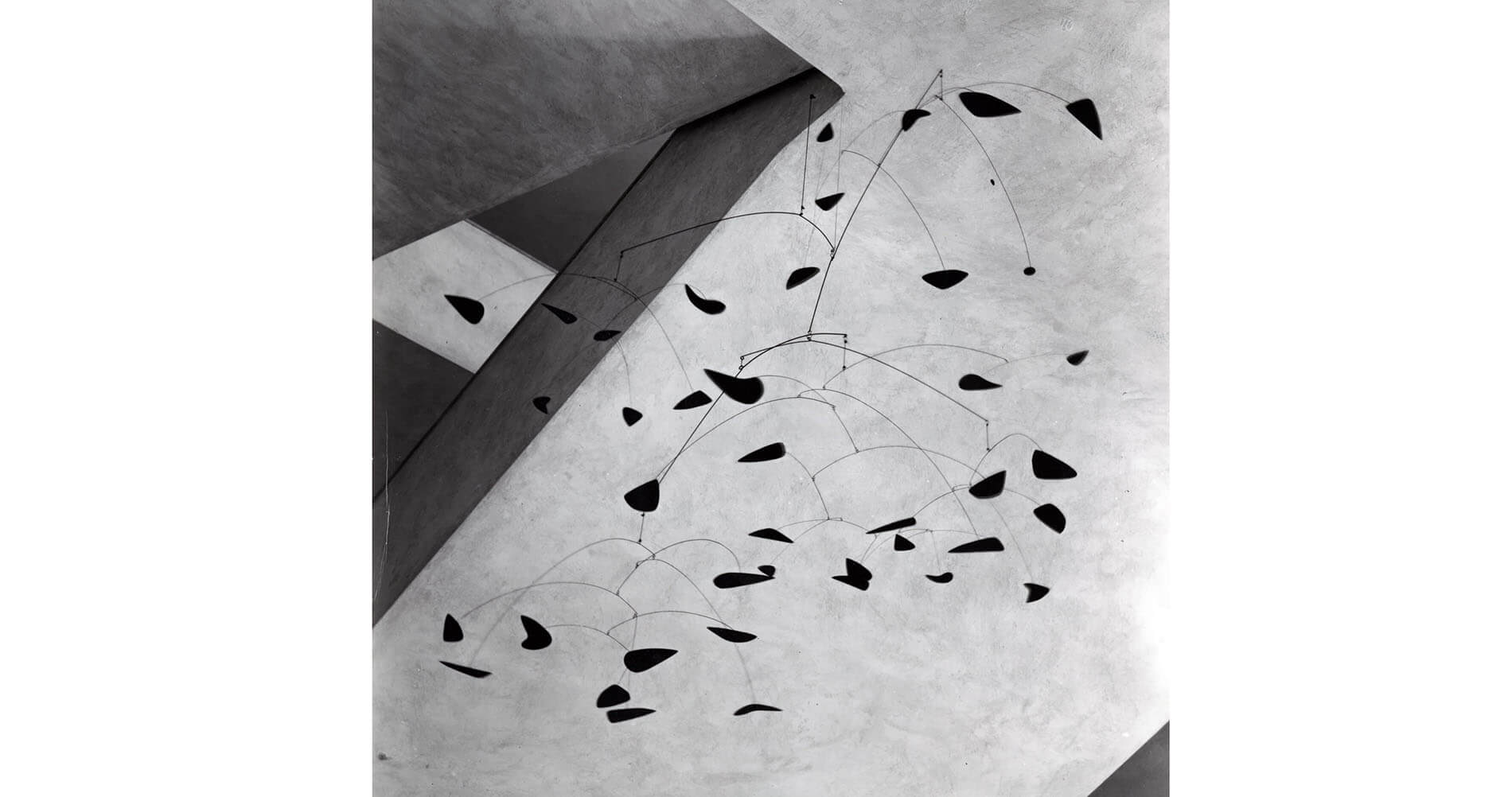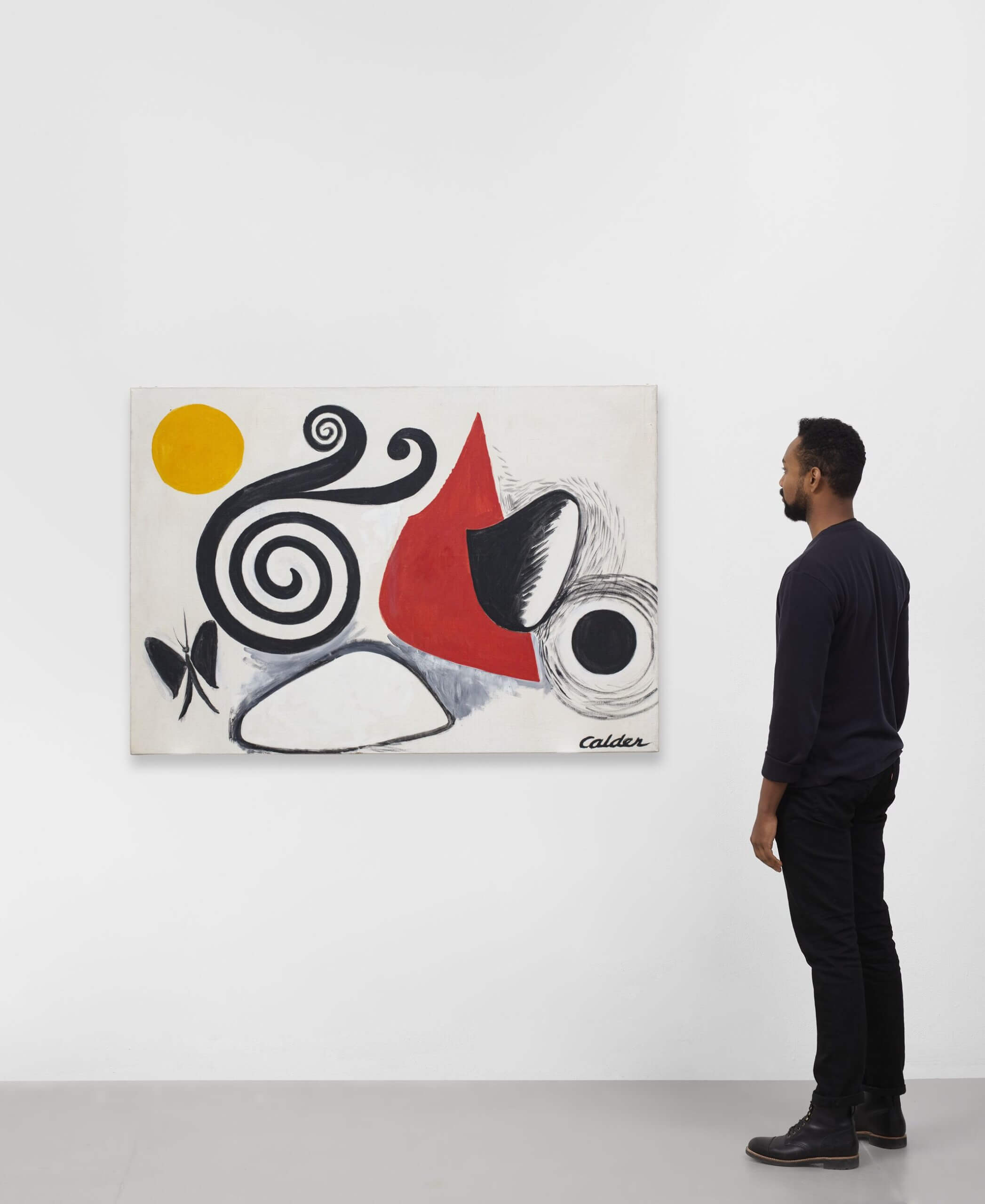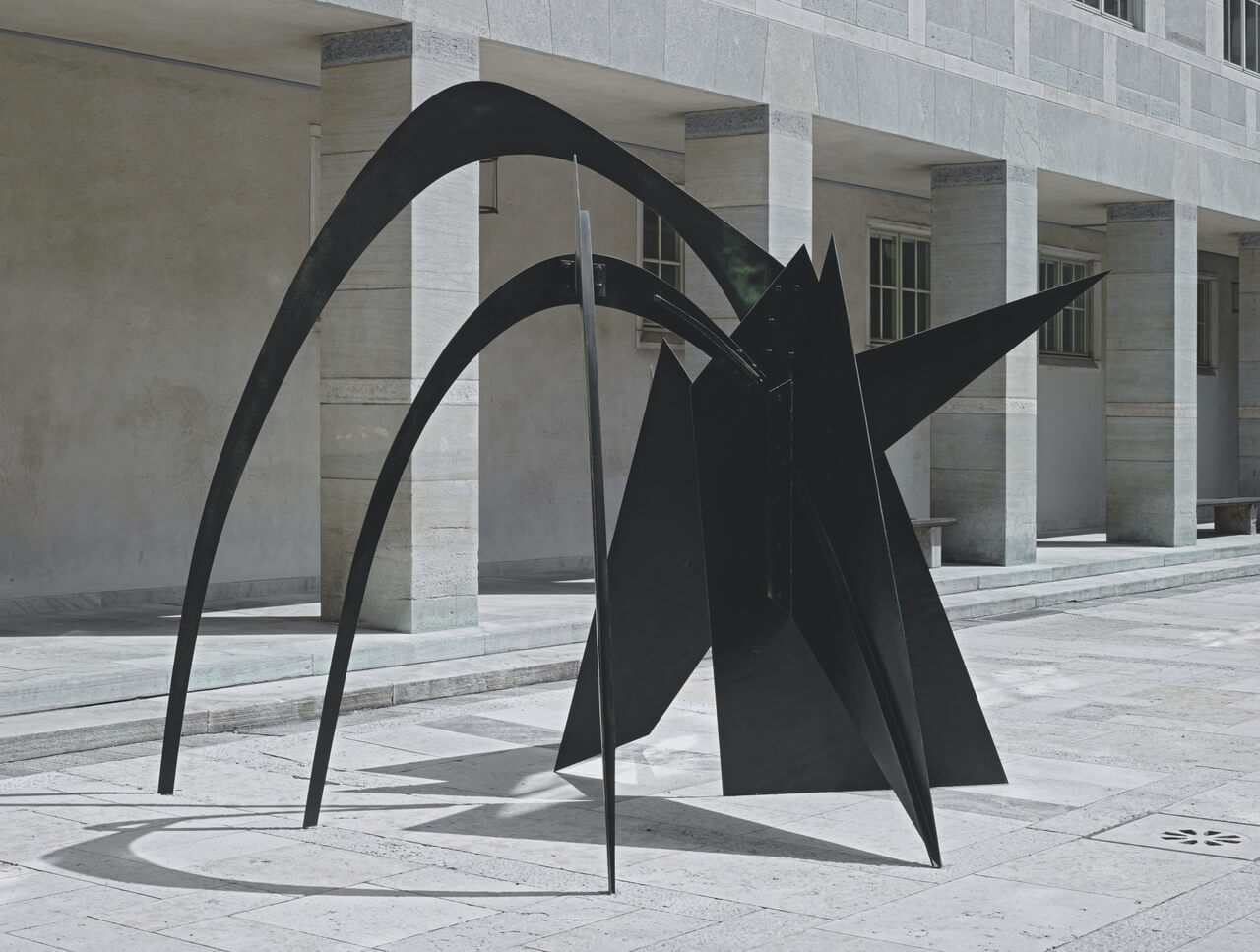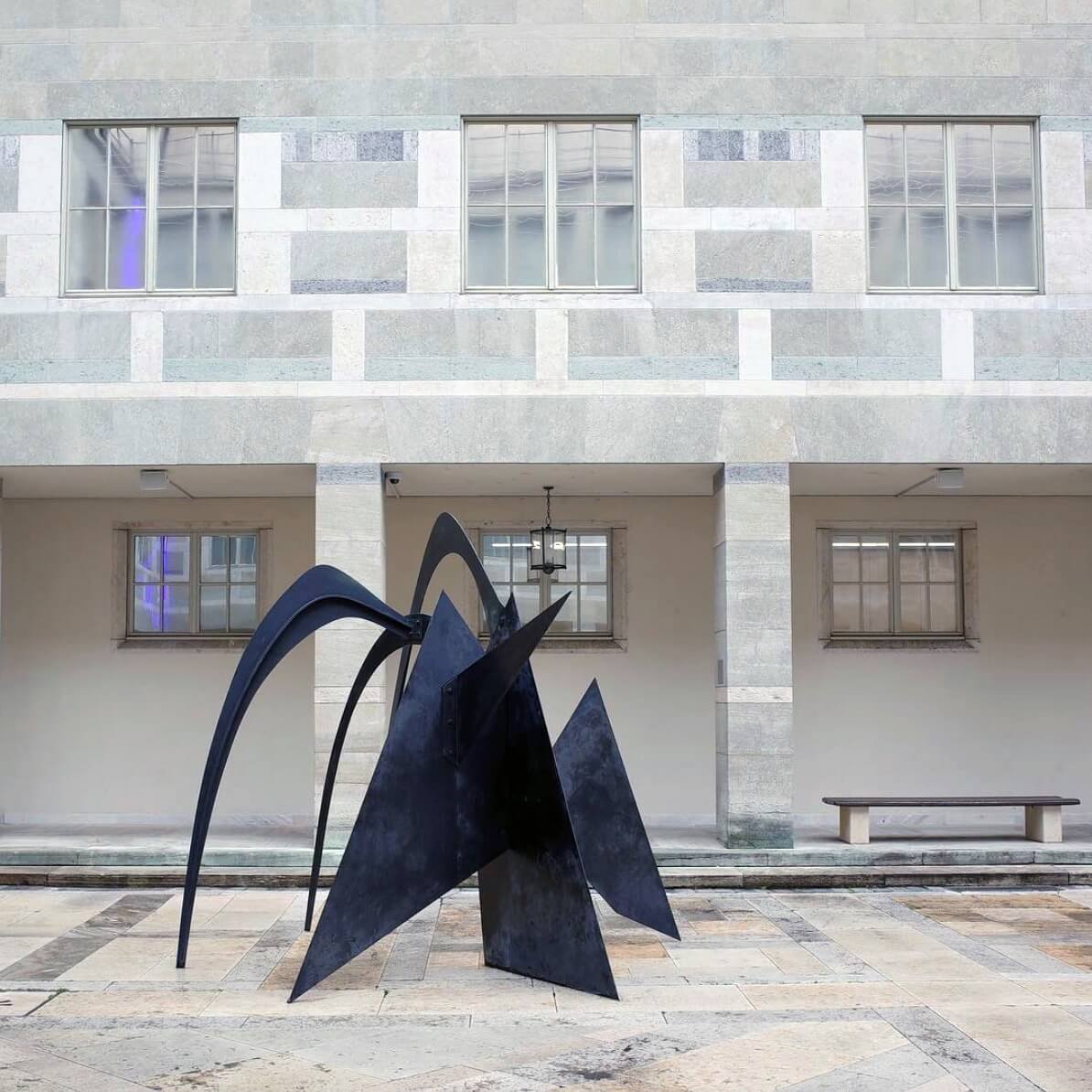
Alexander Calder
Crag

Crag
1974 Sheet metal, wire and paint 199.4 x 243.8 x 96.5 cm / 78 1/2 x 96 x 38 in Signed and dated ‘CA 74’ on base and ‘CA 75’ on uppermost red element
© 2020 Calder Foundation, New York / Artists Rights Society (ARS), New York / ProLitteris, Zurich
Crag
Alexander Calder revolutionised sculpture in the twentieth century with his insatiable and inexhaustible desire to create. Celebrated for his radical mobiles of lively suspended constellations, he ingeniously freed the state of sculpture from its static plinth.
Combining the fluttering grace of the artist’s mobiles with the dramatic grandeur of his stabiles, 'Crag' (1974) is a seminal late work that exemplifies the culmination of Calder's decades-long exploration and synthesis of painterly and sculptural idioms. Standing nearly two metres high, with a two-and-half metre span, 'Crag' (1974) is anchored by a fantastical base that is adorned with gently oscillating floating discs. Made from the artist's signature black-painted sheet metal, steep sloping curves and perforations suggest the geological dimensions –– peaks, valleys and rocky terrains –– and yet the work is entirely nonobjective. It is an exquisite monument to movement, a harmonious union of exuberant spontaneity and steadfast gravitas.
Shapes with Butterfly
1963 Oil on linen 80.6 x 115.9 cm / 31 3/4 x 45 5/8 in Inscription ‘Calder’ lower right recto, signed later
© 2020 Calder Foundation, New York / Artists Rights Society (ARS), New York / ProLitteris, Zurich
Shapes with Butterfly
Renowned chiefly for his lyrical mobiles and monumental stabiles, Alexander Calder started his career as a painter. He was first inspired to paint in 1922, when working as a timekeeper in a Washington State logging camp, he was struck by the beauty of his mountainous surroundings and wrote home for painting materials. These first figurative paintings gesture towards the artist's later fascination with movement and space. Often overlooked as a painter, Calder returned time and again to two dimensions throughout his career. 'Shapes with Butterfly', 1963, encapsulates Calder's enduring enthusiasm for animals and the natural world. 'ANIMALS-ACTION', he wrote in his 1926 book, 'Animal Sketching', 'These two words go hand in hand in art...there is always a feeling of perpetual motion about animals and to draw them successfully this must be borne in mind'. [1] Here, a butterfly hovers in the lower left hand corner of the painting. While Calder's painting is largely non-representational, in 'Shapes with Butterfly' a yellow orb and unfurling spirals suggest an outdoor setting: the burning sun and gentle breeze of a summer's day.
In 1923, at the age of twenty-five, Calder enrolled in a painting course at the Art Students League in New York. While his tutors painted principally in oils, Calder favoured gouache, which he felt was better suited to the spontaneity he sought in his pictures. Indeed, from the 1940s onwards, Calder rarely painted in oils. Yet, Calder's oil paintings demonstrate a mastery of the medium: the slower process inspired a more deliberate oeuvre, which marries the vibrant colour and inventive composition of his gouaches with the spirit of his visionary sculptures. Painted in 1963, 'Shapes with Butterfly' was created in Calder's studio in Saché, a small village near Tours in the Loire Valley. In 1954 Calder had bought a house there and he immediately set about establishing a small painting studio in a nearby cottage, which he fitted out with whitewashed walls and sealed windows. In this hermetic space Calder worked energetically, painting works that abstracted elements of nature and the landscape around Saché that he found so stimulating. With its invigorating composition and bold colouration, 'Shapes with Butterfly' is amongst the artist's most accomplished paintings. Employing his signature palette of red, yellow and black, the work pays tribute to Calder's close relationship with Joan Miró. The artists became friends during Calder's sojourn in Paris in the late 1920s, and their connection was solidified at Calder's Connecticut residence where they continued to exchange ideas, reinforcing the resemblance between their styles. It was Miró who influenced Calder away from traditional modes of representation and towards a language of Surrealist abstraction. Another of Calder's formative influences was Piet Mondrian. In 1930, a visit to Mondrian's studio turned out to be a transformative experience for Calder. 'Though I had heard the word 'modern' before', he recalled, 'I did not consciously know or feel the term 'abstract'. So now, at thirty-two, I wanted to paint and work in the abstract'. [2] Invoking a visual language that treads the boundary between abstraction and figuration, 'Shapes with Butterfly' channels the influence of Mondrian and Miro, while remaining true to Calder’s own personal iconography and intoxicating joie de vivre.
[1] Alexander Calder, quoted in Ruth Wolfe (ed.), Jean Lipman, 'Calder's Universe', Philadelphia PA: Running Press, 1976, p. 82. 2) Ibid., p. 112.
Celebrating Basel Basel
In the central courtyard of Kunstmuseum Basel, Calder’s Spider stands almost 10 foot tall. Installed in 1960, it was donated to the museum by Dr. H. C. Maja Sacher-Stehlin on the occasion of the 500th anniversary of Basel University.
Alexander Calder, Spider, 1959, Kunstmuseum Basel © 2020 Calder Foundation, New York / Artists Rights Society (ARS), New York. Photo: @hatomicha.
‘You have to walk around a stabile or through it—a mobile dances in front of you. You can walk through my stabile at the Basel museum. It’s a bunch of triangles leaning against each other with several large arches flying from the mass of triangles.’—Alexander Calder

In the stairwell of the museum, ‘Five Branches with 1000 Leaves, c. 1946’ hangs from the ceiling. It was featured in the major group exhibition ‘Sculpture on the Move 1946—2016’, alongside work by Max Bill, Louise Bourgeois, Constantin Brancusi, and Eduardo Chillida, among others.
Alexander Calder, Five Branches with 1000 Leaves, ca. 1946 © 2020 Calder Foundation, New York / Artists Rights Society (ARS), New York



